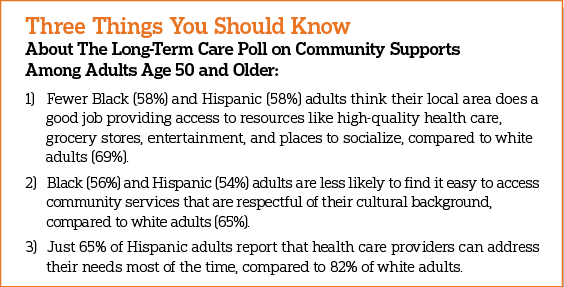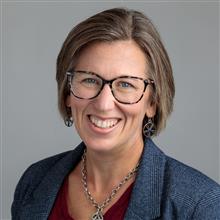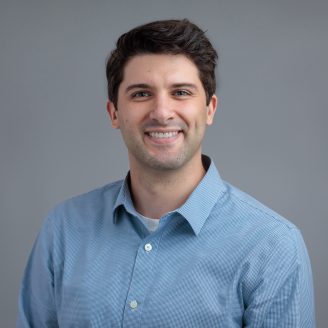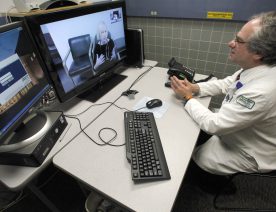
April 27, 2022
Older adults by and large feel prepared to age in their current communities and are confident in the availability of and access to services in their community that will support their ability to age at home. But while still holding a generally positive outlook, some segments of this population—especially those with lower incomes, those living in rural areas, and Black or Hispanic older adults—have more reservations about the services in their area that support aging.
A new study of adults age 50 and older from The AP-NORC Center for Public Affairs Research and The SCAN Foundation finds that a majority of these adults feel prepared to stay in their homes and communities as long as possible, and they feel ready to reach out for help from a loved one or health care provider as they need it. Two-thirds think their area meets their needs for services like health care, grocery stores, and social opportunities. Few report having a hard time accessing needed services because of communication obstacles like a language barrier (11%), cultural barrier (8%) or age gap (8%); issues with affordability (15%); or issues of respect for their religious (4%) or cultural (3%) background. Health care services of all types are widely perceived as easy to access in their local area, and most feel health care providers in their area understand their needs (79%) and take their concerns seriously (79%).
But, a closer examination of the small proportion of older Americans who feel less prepared and less supported in their community raises concerns about equity in access to the resources necessary to age in place.
When it comes to preparedness, older Hispanic adults are less likely than their white counterparts to feel prepared to remain in their own home (59% vs. 73%), stay in their current communities (60% vs. 73%), and obtain assistance from health care providers (53% vs. 67%). Both Black and Hispanic older adults are less likely than white older adults to rate their community as doing a good job providing access to resources like high-quality health care, grocery stores, and places to socialize (58% each vs. 69%). Fewer Black and Hispanic older adults also think it is easy to find services in their area that are respectful of their language (71% and 69%, respectively, vs. 82%) or cultural background (56% and 54% vs. 65%). Black adults in particular cite a lack of healthy foods and the kinds of food they want, while Hispanics cite a lack of affordable housing.
Looking specifically at the health care system, though majorities of each find these services easy to access, Black and Hispanic older adults are less likely than white adults to think it would be easy to access pharmacies (89% and 88%, respectively, vs. 95%), physical therapy (75% and 69% vs. 85%), and dental care (76% and 75% vs. 86%). And while most older adults think local health care providers understand their needs and take them seriously, older Hispanics are less likely than their white counterparts to think so. Many of these issues are more severe among lower-income Hispanic older adults.
In addition to race and ethnicity, those in urban areas—and suburban areas especially—describe their communities as having more supports for aging in place than those in rural areas. Older adults in suburban areas see their communities as doing the best job with meeting needs for healthy food, internet access, and the kinds of foods they want to eat. Suburban areas are also seen as better than rural areas in particular at meeting needs for health care and social activities. Older rural Americans are less likely than those living elsewhere to use a range of services simply because they aren’t available in their area. They are less likely to feel that community services are easy to get and designed for people their age than those in urban or suburban communities as well. And they are less likely to think a variety of health care services would be easy for them to access.
Income disparities are also associated with access to critical aging services. Those with incomes of $50,000 and below are less likely than those earning more to have access to services that are in their language (73% vs. 82%), close by or easy to get to (58% vs. 65%), respectful of their religious beliefs (57% vs. 65%), or designed for people their age (53% vs. 63%). When it comes to medical services, they are also less likely to have easy access to dental care, physical therapy, pharmacies, nursing homes, and urgent care than those earning more.
Additionally, those age 65 and older generally feel more prepared and report better access to important community services than those ages 50-64.

The AP-NORC Center conducted this study with funding from The SCAN Foundation (TSF). The survey includes 1,762 interviews with a nationally representative sample of adults age 50 and older living in America using the Foresight 50+ Panel, the probability-based panel of adults age 50 and older of NORC at the University of Chicago. Interviews were conducted between February 24 and March 1, 2022, online and by phone in English and Spanish. The margin of sampling error is +/- 3.4 percentage points.
Suggested Citation: The AP-NORC Center for Public Affairs Research. (April, 2022). “Equity and Aging in the Community” [https://apnorc.org/projects/equity-and-aging-in-the-community]









